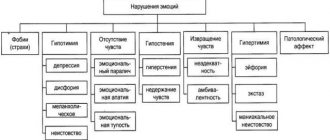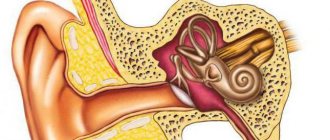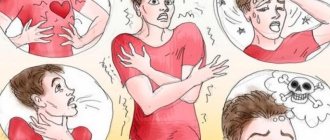Violations of the emotional-volitional sphere of the child
Despite the fact that you should not independently make not only medical diagnoses, but also diagnoses in the field of psychological health, and it is better to entrust this to professionals, there are a number of signs of disturbances in the emotional-volitional sphere, the presence of which should be the reason for contacting specialists.
Violations in the emotional-volitional sphere of a child’s personality have characteristic features of age-related manifestations. So, for example, if adults systematically note in their child at an early age such behavioral characteristics as excessive aggressiveness or passivity, tearfulness, “getting stuck” on a certain emotion, then it is possible that this is an early manifestation of emotional disorders.
Emotional tension. With increased emotional tension, in addition to well-known manifestations, difficulties in organizing mental activity and a decrease in play activity characteristic of a particular age can also be clearly expressed.
- The rapid mental fatigue of a child in comparison with peers or with earlier behavior is expressed in the fact that the child has difficulty concentrating, he may demonstrate a clear negative attitude towards situations where the manifestation of thinking and intellectual qualities is necessary.
- Increased anxiety. Increased anxiety, in addition to the known signs, can be expressed in avoidance of social contacts and a decrease in the desire to communicate.
- Aggressiveness. Manifestations can be in the form of demonstrative disobedience to adults, physical aggression and verbal aggression. Also, his aggression can be directed at himself, he can hurt himself. The child becomes disobedient and with great difficulty succumbs to the educational influences of adults.
Anxiety
This is melancholy that is projected into the future, expressed mental anxiety, anxiety caused by the groundless expectation of a catastrophe, a major trouble that will happen to the patient or his loved ones. Anxiety can be caused by a specific event associated with a specific, often exaggerated situation in life, or diffuse, not associated with any events or facts. Such a disorder is usually accompanied by intense autonomic reactions and motor agitation. It is closely related to depressive conditions and acts as part of a single anxiety-depressive syndrome in various somatic and mental disorders, especially often occurring in involutionary age.
Correction of disorders of the emotional-volitional sphere in childhood
What to do if the baby’s behavior suggests the presence of such a disorder? First of all, it is important to understand that these violations can and should be corrected. You should not rely only on specialists; the role of parents in correcting the behavioral characteristics of the child’s character is very important.
An important point in laying the foundation for a successful resolution of this problem is the establishment of contact and trust between parents and the child. In communication, you should avoid critical assessments, show a friendly attitude, remain calm, praise adequate manifestations of feelings more, you should be sincerely interested in his feelings and empathize.
To eliminate disturbances in the emotional sphere, you should contact a child psychologist, who, with the help of special classes, will help you learn how to react correctly when stressful situations arise and control your feelings. Another important point is the work of the psychologist with the parents themselves.
Psychology currently describes many methods for correcting childhood disorders in the form of play therapy. As you know, the best learning occurs with the involvement of positive emotions. Teaching correct behavior is no exception.
The value of a number of methods lies in the fact that they can be successfully used not only by specialists themselves, but also by parents interested in the organic development of their baby.
Practical correction methods
If parents in the process of upbringing pay sufficient and due attention to such aspects of the development of the child’s personality as the emotional-volitional sphere, then in the future this will make it much easier to survive the period of teenage personality formation, which, as many know, can introduce a number of serious deviations in the child’s behavior.
The work experience accumulated by psychologists shows that not only taking into account the characteristics of age-related development, a thorough selection of diagnostic methods and psychological correction techniques allows specialists to successfully solve problems of violation of the harmonious development of a child’s personality, the decisive factor in this area will always be parental attention, patience, care and love .
Psychologist, psychotherapist, personal well-being specialist
Treatment
Treatment must be supervised by loved ones, since individuals with borderline disorder tend to leave therapy as soon as they feel better. They return again when there is a natural deterioration. Obviously, such treatment will not produce results.
People with borderline disorder need regular motivation and support, empathy. The name of the disorder speaks for itself - patients are constantly on the brink of feelings, emotions, decisions, and so on, moving first to one side, then to the other. By doing this, they drive everyone around them, and sometimes even their treating doctors, into a state of frustration.
People with borderline disorder are very difficult to help. The most effective means for correcting the condition today is dialectical behavior therapy by Marsh Linech. Therapy includes the following components:
- Cognitive behavioral therapy. The goal is to teach the patient self-control and the “here and now” principle.
- Dialectical approach. It involves working with cause-and-effect relationships, namely eliminating boundaries and changing the thinking “as I did, so it will be” to “either this, or this will be the case.” Truth is formed cumulatively, including on the basis of contradictions. It is useless to reason logically or have a calm conversation with a person suffering from a borderline state.
- The principle of harmony. Various meditation and relaxation techniques are necessary to understand the unity of the world and the connection of all its parts, including opposite ones. A person must realize and accept himself and his experience, establish connections between the past and the present. The very basis of relaxation is contradictory - to accept, but at the same time to detach, and sometimes to change due to acceptance. For example, you need to accept psychological trauma for the sake of your own changes.
- Metaphors. During therapy, it is important to keep the patient active and stimulate him to move. This is done using healthy humor, metaphors and the principle that "patients may not have created all their problems, but they must solve them one way or another."
The author described the subtleties of therapy, principles, technology, and even the metaphors themselves in his book “Cognitive-Behavioral Therapy for Borderline Personality Disorder.” Therapy lasts at least a year and is performed on an outpatient basis. The main elements of treatment include individual and group psychotherapy. Sometimes drug therapy or hospitalization is used when the patient is in crisis.
During individual sessions, the patient fills out a diary. Sessions are built in a certain sequence:
- life-threatening behavior is discussed first;
- then – behavior that interferes with psychotherapy and reduces the quality of life;
- Afterwards, the patient learns constructive behavior skills.
The method of dialectical cognitive behavioral therapy requires a lot of time and money, and also places severe demands on the professionalism of the specialist. But so far this is the most effective method of correcting borderline disorder. It is impossible to independently help a person with a disorder with socialization.
External manifestations of disorders of the emotional-volitional sphere in childhood
In preschool age, the above symptoms may be supplemented by the inability to follow norms and rules of behavior and insufficient development of independence. At school age, these deviations, along with those listed, can be combined with self-doubt, impaired social interaction, decreased sense of purpose, and inadequate self-esteem.
It is important to understand that the existence of disorders should be judged not by the presence of a single symptom, which may be the child’s reaction to a specific situation, but by the combination of several characteristic symptoms.
The main external manifestations are as follows:
Parents observe the manifestation of emotions from the very beginning of the child’s life; with their help, communication with parents occurs, so the baby shows that he feels good, or he experiences unpleasant sensations.
Later, as the child grows up, problems arise that he has to solve with varying degrees of independence. Attitude to a problem or situation causes a certain emotional response, and attempts to influence the problem cause additional emotions. In other words, if a child has to show arbitrariness in carrying out any actions, where the fundamental motive is not “I want”, but “I need”, that is, volitional effort will be required to solve the problem, in fact this will mean the implementation of a volitional act.
As we grow older, emotions also undergo certain changes and develop. Children at this age learn to feel and are able to demonstrate more complex manifestations of emotions. The main feature of the correct emotional-volitional development of a child is the increasing ability to control the manifestation of emotions.
The main causes of violations are:
- suffered stress;
- retardation in intellectual development;
- lack of emotional contacts with close adults;
- social and everyday reasons;
Violations of the children's emotional sphere manifest themselves much more often and more clearly during periods of so-called age-related crises. Vivid examples of such points of maturation can be the crises “I myself” at the age of three and the “Crisis of adolescence” in adolescence.
To correct disorders, timely and correct diagnosis is important, taking into account the causes of the development of deviations. Psychologists have a range of special techniques and tests to assess the development and psychological state of a child, taking into account his age characteristics.
For preschoolers, projective diagnostic methods are usually used:
- drawing test;
- Luscher color test;
- questionnaire “Well-being, activity, mood” (SAM);
Be smart!
The work was added to the website samzan.ru: 2016-06-20
Promotion
For free
Find out the cost of work
Content
Introduction………………………………………………………………………………3
Causes of disturbances in the emotional-volitional sphere………….4
Violation of the emotional-volitional sphere using the example of childhood autism.....13
Conclusion………………………………………………………………………………….……17
References……………………………………………………………18
Introduction
Social adaptation of children with developmental disorders is the most important task of special pedagogy and psychology. The process of social adaptation is most difficult in persons with severe developmental disorders, combined disorders, as well as disorders of the emotional-volitional sphere of a primary nature. Violations of the emotional-volitional sphere of a primary nature include not only the classic forms of childhood autism, but also variants in which the condition occurs later than the specified period or does not meet one of the identified diagnostic criteria or is combined with other developmental disorders that are not secondary. Therefore, to designate this group in the specialized literature, the terms “children with developmental disorders such as early childhood autism”, “children with communication disorders”, “children with primary affective disorders” are also used.
According to statistics, childhood autism ranks fourth among neuropsychic pathologies in childhood; intellectual disability is observed in more than half of all cases of childhood autism. Significant difficulties in training, education, and social adaptation, due to the specific nature of the disorder, determine the high percentage of disability in this group in the future.
Thus, the problem of carrying out correctional work with autistic children is extremely acute and attracts the close attention of teachers, psychologists, and doctors. Interaction, being an objective and universal form of development, determines the existence and structural organization of any system. And it is interaction with an adult, with other children, that plays the most important role in the mental development of a child (L.I. Bozhovich, L.S. Vygotsky, A.V. Zaporozhets, A.N. Leontiev, M.I. Lisina, D.B. .Elkonin and others). Features of dysontogenesis in childhood autism lead to the fact that in the process of interaction with the outside world, an autistic child receives predominantly negative experiences, which leads to the emergence of defense mechanisms that increase behavioral difficulties and significantly complicate the process of forming adequate communication and any joint activities (V.V. Lebedinsky , O.S. Nikolskaya).
Causes of disorders of the emotional-volitional sphere
Disorders of emotional development in children are caused by two groups of reasons:
Constitutional reasons (type of the child’s nervous system, biotonus, somatic features, that is, disruption of the functioning of any organs).
Genetic factors play an important role in the development of psychophysiological characteristics of the nervous system. Being a genetically fixed “specialization” of the style of behavior in extreme situations, temperament can determine the nature of the child’s experiences and internal conflict in response to psychological stress factors, but its action alone is not enough to cause certain emotional disorders to occur.
Features of a child's interaction with the social environment. The child has his own experience of communicating with adults, peers and a particularly significant group for him - the family, and this experience can be unfavorable:
- If a child is systematically subjected to negative evaluations from an adult, he is forced to repress into the unconscious a large amount of information coming from the environment. New experiences that do not coincide with the structure of his “I-concept” are perceived negatively by him, as a result of which the child finds himself in a stressful situation.
- When relationships with peers are dysfunctional, emotional experiences arise that are characterized by severity and duration: disappointment, resentment, anger.
- family conflicts, different demands on the child, misunderstanding of his interests can also cause him negative experiences. The following types of parental attitudes are unfavorable for emotional and personal development: rejection, overprotection, treatment of the child according to the principle of a double bond, excessive demands, avoidance of communication, etc. Among the emotional traits that develop under the influence of such parental relationships, aggressiveness, self-aggression, and lack of ability are noted. to emotional decentration, feelings of anxiety, suspiciousness, emotional instability in communicating with people. Whereas close, intense emotional contacts, in which the child is “the object of a friendly, but demanding, evaluative attitude, ... form confidently optimistic personal expectations in him.”
Relationships in the family are at the epicenter of theoretical and experimental research, focusing on the influence of the environment as a risk factor for the occurrence of emotional distress in children. Any emotional disturbance in a child is considered a product and indicator of a family abnormality and is considered a disturbance for the entire family. Most psychological concepts do not dispute this; the difference lies in which aspect of this relationship is considered to be decisive. Violations are recorded mainly at the personal level (neurotic disorders, adaptation disorders, etc.).
According to the pathogenetic concept of V.N. Myasishchev, “... affective-volitional disorders represent a secondary product of the child’s relationships with others, a product of internal tension arising in connection with this, a product of incorrect attitudes and relationships.”
V. N. Myasishchev’s position on the pathogenic role of family conflicts and the inconsistency of the parents’ relationship with the child is confirmed and concretized by a number of domestic clinical and psychological studies aimed at identifying unfavorable factors in upbringing, the intra-family atmosphere that accompany the child’s emotional distress.
Thus, V.I. Garbuzov, A.I. Zakharov, D.N. Isaev identify three main types of improper upbringing, which is the decisive factor that shapes the personality traits of children predisposing to the occurrence of neurotic reactions:
Rejecting (non-acceptance). Conditioned by a number of conscious and more often unconscious factors, it implies excessive demands, strict regulation and control, or a lack of control due to connivance.
Hypersocializing. It manifests itself in excessive concern for the future of the child and his family, arising from the parents’ anxious suspicion regarding the health of the child and other family members, and the child’s social status.
Egocentric. The idea of “I am big” is imposed on the child as a self-pressing value for others 3; 7; 9.
The work of A. Ya. Varga describes three pathogenic types of parental relationships that are unfavorable for the child: symbiotic, authoritarian and emotionally rejecting, characterized by attributing illness and personal failure to the child.
Various studies also indicate a connection between emotional disturbances in preschool age and the loss of physical and emotional contact with the mother due to death or placement in nurseries and kindergartens, the adverse effects of a preschool institution.
The reasons for the emergence of negative tendencies in the behavior of preschoolers include the subject environment, the content of which (for example, toys that stimulate aggression) influences the choice of the plot of children's games, the implementation of role behavior and corresponding emotional expression.
G. M. Breslav classifies emotional disorders as:
- lack of emotional decentration - the child is not able to empathize either in a real situation or when listening to literary works;
- lack of emotional syntony - the child is not able to respond to the emotional state of another person, especially a close or sympathetic one;
- absence of a specific phenomenon of emotional self-regulation - the child does not experience guilt associated with a new stage of self-awareness (“I did this”) and the ability to emotionally return to the past.
G. E. Sukhareva, V. V. Kovalev and other authors note the presence in neurasthenic children of such an emotional disorder as increased affective excitability. The child quickly develops a state of anger over minor reasons; after an affective discharge, he may cry and feel guilty
Yu. M. Milanich divides children with emotional disorders into three groups. The first group includes children with pronounced intrapersonal conflicts. Parents and teachers note anxiety, unreasonable fears, and frequent mood swings in these children.
The second group consists of children with interpersonal conflicts. These children are characterized by increased emotional excitability, irritability, and aggressiveness.
The third group consists of children with both intrapersonal and interpersonal conflicts. They are characterized by emotional instability, irritability, aggressiveness, on the one hand, and resentment, anxiety, suspiciousness and fears, on the other hand.
From the entire array of detected emotional disorders, Yu. M. Milanich distinguishes three groups:
- acute emotional reactions that color specific conflict situations for the child: aggressive, hysterical, protest reactions, as well as reactions of fear and excessive resentment;
- intense emotional states – supra-situational negative experiences that are more stable over time: gloominess, anxiety, depressed mood, fearfulness, timidity;
- disturbances in the dynamics of emotional states: affective explosiveness and lability (rapid transitions from positive emotions to negative ones and vice versa).
The most complete and consistent classification of disorders in the development of the child’s emotional sphere, proposed by I. O. Karelina. She identifies three groups of disorders in the development of the emotional sphere of a preschooler:
- mood disorders;
- behavioral disorders;
- psychomotor disorders.
Mood disorders can be divided into 2 types: with increased emotionality and its decrease. The first group includes conditions such as euphoria, dysphoria, depression, anxiety syndrome, and fears. The second group includes apathy, emotional dullness, and parathymia.
Euphoria is an elevated mood not associated with external circumstances. A child in a state of euphoria is characterized as impulsive, striving for dominance, and impatient.
Dysphoria is a mood disorder with a predominance of angry-sad, gloomy-dissatisfied, with general irritability and aggressiveness. A child in a state of dysphoria can be described as sullen, angry, harsh, unyielding.
Depression is an affective state characterized by a negative emotional background and general passivity of behavior. Depression in preschool age in its classic form is usually atypical and erased. A child with a low mood can be described as unhappy, gloomy, pessimistic.
Anxiety syndrome is a state of causeless concern, accompanied by nervous tension and restlessness. A child experiencing anxiety can be defined as insecure, constrained, and tense.
Fear is an emotional state that occurs when one perceives an impending danger. A preschooler who experiences fear looks timid, frightened, and withdrawn.
Apathy is an indifferent attitude towards everything that happens, which is combined with a sharp drop in initiative. An apathetic child can be described as lethargic, indifferent, passive.
Emotional dullness is a flattening of emotions, primarily the loss of subtle altruistic feelings while maintaining elementary forms of emotional response.
Parathymia, or inadequacy of emotions, is a mood disorder in which the experience of one emotion is accompanied by the external manifestation of an emotion of the opposite valence.
Emotional dullness and parathymia are characteristic of children suffering from schizophrenia.
Behavioral disorders include hyperactivity and aggressive behavior: normative-instrumental aggression, passive-aggressive behavior, infantile aggression, defensive aggression, demonstrative aggression, targeted hostile aggression 24; 28.
Hyperactivity is a combination of general motor restlessness, restlessness, impulsiveness of actions, emotional lability, and impaired concentration. A hyperactive child is restless, does not finish what he starts, and his mood changes quickly.
Normative-instrumental aggression is a type of childhood aggressiveness, where aggression is used mainly as a norm of behavior in communication with peers.
An aggressive child behaves defiantly, is restless, pugnacious, takes initiative, does not admit his guilt, and demands the submission of others. His aggressive actions are a means to achieve a specific goal, so he experiences positive emotions upon achieving the result, and not at the moment of aggressive actions.
Passive-aggressive behavior is characterized by whims, stubbornness, a desire to subjugate others, and an unwillingness to maintain discipline.
Infantile aggressiveness manifests itself in the child’s frequent quarrels with peers, disobedience, making demands on parents, and the desire to insult others.
Defensive aggression is a type of aggressive behavior that manifests itself both normally (an adequate response to external influences) and in an exaggerated form, when aggression occurs in response to a variety of influences.
The occurrence of hypertrophied aggression may be associated with difficulties in decoding the communicative actions of others.
Demonstrative aggression is a type of provocative behavior aimed at attracting the attention of adults or peers. In the first case, the child uses verbal aggression in indirect form, which manifests itself in various statements in the form of complaints about a peer, in a demonstrative cry aimed at eliminating the peer. In the second case, when children use aggression as a means of attracting the attention of peers, they most often use physical aggression - direct or indirect, which is involuntary, impulsive in nature (directly attacking another, threats and intimidation - as an example of direct physical aggression or destruction products of the activity of another child in the case of indirect aggression).
Purposeful hostile aggression is a type of childhood aggressiveness where the desire to harm another is an end in itself. Aggressive actions of children, bringing pain and humiliation to peers, do not have any visible goal - neither for others, nor for themselves, but imply pleasure from causing harm to others. Children use mainly direct physical aggression, while their actions are particularly cruel and cold-blooded, and there are absolutely no feelings of remorse.
Psychomotor disorders include:
- amymia - lack of expressiveness of the facial muscles, observed in certain diseases of the central or peripheral nervous system;
- hypomimia - a slight decrease in the expressiveness of facial expressions;
- unexpressive pantomime.
As T.I. Babaeva emphasizes, the condition for the socio-emotional development of a child is his “ability to “read” the emotional state of the people around him, to empathize and, accordingly, to actively respond to it.”
Therefore, disorders in the emotional development of a preschooler include difficulties in adequately determining the emotional states of people, since in the practice of teaching and raising children, the task of forming emotionality is solved only in fragments, and primary attention is paid to the development of thought processes. One of the reasons for this situation is the lack of coverage of the issue of emotional impact.
So, a violation of the emotional balance contributes to the emergence of emotional disorders, leading to deviations in the development of the child’s personality and to disruption of his social contacts.
There are three groups of disorders in the development of the child’s emotional sphere:
mood disorders;
behavioral disorders;
psychomotor disorders.
Behavioral disorders include hyperactivity and aggressive behavior: normative-instrumental aggression, passive-aggressive behavior, infantile aggression, defensive aggression, demonstrative aggression, targeted hostile aggression.
Violation of the emotional-volitional sphere using the example of childhood autism Autism is a mental disorder characterized by a pronounced deficit in personal, social, speech and other aspects of development and communication skills. Characterized by: a tendency to self-isolation, isolation from the real world and loss of connections with it, immersion in the world of personal experiences, absence or loss of social skills, complete or partial absence of language skills, repetitive or stereotypical actions and interests, aimed primarily at inanimate objects.
The term autism was introduced in 1912 by E. Bleuler to designate a special type of thinking that is regulated by a person’s emotional needs and does not depend on reality. Childhood autism syndrome as an independent clinical entity was first identified by L. Kanner in 1943. Descriptions of such conditions and attempts at correctional work with such children have been known since the beginning of the 19th century. Almost simultaneously with L. Kanner, H. Asperger (1944) and S.S. came to the formulation of similar clinical problems. Mnukhin (1947). More than half a century of clinical research has confirmed L. Kanner's hypothesis about the existence of a special syndrome or a special group of syndromes associated with childhood autism. A detailed acquaintance of specialists with the history of the clinical study of childhood autism and its modern clinical classifications is possible thanks to the works of V.M. Bashina (1999). The origin of autism can vary. To a mild degree, it can occur with constitutional characteristics of the psyche (accentuation of character, psychopathy), as well as in conditions of chronic mental trauma (austic personality development). Or it can act as a gross anomaly of mental development (early childhood autism).
Within the framework of psychoanalysis, autism is considered as a result of early psychogenic influence caused by an indifferent, cold attitude on the part of the mother. Early psychological stress, a specific pathology of parent-child relationships, leads to pathological personality development. However, the results of numerous studies of patients with autism, indicating its connection with organic and genetic factors, as well as studies of the interaction of mothers with children suffering from autism, made it possible to refute the assertion that the personal characteristics of mothers and their negative attitude towards the child are the cause of the development of the disease. Other concepts that focus on affective disorders can be divided into 2 groups. According to the theories of the first group, the cause of all manifestations of autism is emotional disturbances. According to the authors of the concepts of the second group, affective disorders also determine interaction with the world in patients with autism, however, they themselves are derived from specific cognitive impairments.
The most consistent and detailed concept belonging to the first group is considered to be the theory of V.V. Lebedinsky, O.S. Nikolskaya. According to this concept, biological deficiency creates special pathological conditions to which the autistic child is forced to adapt. From the moment of birth, a typical combination of two pathogenic factors is observed:
- impaired ability to actively interact with the environment, which manifests itself in decreased vitality;
- lowering the threshold of affective discomfort in contacts with the world, manifested in painful reactions to ordinary stimuli and increased vulnerability when contacting another person.
Both of these factors act in the same direction, preventing the development of active interaction with the environment and creating the prerequisites for strengthening self-defense. Autism, according to the authors, develops not only because the child is vulnerable and has little emotional endurance. Many manifestations of autism are interpreted as the result of the inclusion of protective and compensatory mechanisms that allow the child to establish relatively stable, albeit pathological, relationships with the world. Within the framework of this concept, distortion of the development of cognitive functions is a consequence of disturbances in the affective sphere. Features of the formation of motor processes, perception, speech and thinking are directly associated with early onset gross emotional disorders. The leading role of emotional disorders in the development of autism is also emphasized in the theory of R. Hobson. The author views autism primarily as an affective disorder with impaired interpersonal relationships. It is argued that autism is characterized by an innate lack of ability to understand and respond to the affective expressions of others. This is confirmed by the results of experimental studies aimed at studying the ability to evaluate the emotional expression of faces. Due to such a deficit, a child with autism does not receive the necessary social experience during early childhood. The latter leads to inferiority of the cognitive structures necessary for normal communication. Thus, emphasizing the role of emotional disorders in autism and explaining with them the main problems that arise in these patients, the author nevertheless points to the primacy of a specific cognitive deficit.
Communication problems in children with autism are interpreted within another concept, as a consequence of impaired ability to imitate facial expression. Based on the fact that healthy newborns have the ability to imitate visible facial expression, the authors postulate the presence of an innate supramodal body schema that integrates visual and proprioceptive information. By imitating the affective expression of an adult, the child begins to experience the same emotions. This is how “emotional contagion” arises, allowing the child to identify the adult as “something similar to himself.”
The authors believe that in autism, this innate imitation system is damaged, which leads to disruption of interaction with the world. The concepts of autism discussed above see emotional disorders as the main cause of developmental disorders, regardless of whether they are primary or derived from cognitive deficits. According to other theories, it is the impairment of the cognitive sphere that is the source of deviations in such patients.
One of the most famous concepts of this kind is the theory of W. Freef. The basis for its creation was the results of experimental studies and observations that revealed not only a decrease in capabilities, but also specific abilities in patients with autism. Such unusual abilities include, for example, high performance in memorizing words that are not related in meaning, the ability to reproduce meaningless sound combinations, the ability to recognize inverted and noisy images, highlight secondary features when classifying faces, etc. At the same time, patients with autism find it difficult to perform tests for remembering sentences, for classifying faces by emotional expression, for recognizing correctly oriented images, etc.
Thus, most modern researchers point to a primary cognitive deficit in patients with autism. Undoubtedly, creating a theory of autism presents great difficulties. This is primarily due to the fact that this condition includes a spectrum of symptoms that reflect both the deficit and the special abilities of these patients. A full-fledged concept must necessarily consistently explain both, as well as indicate the primary reason underlying the uniqueness of development. In addition, since almost all autism researchers recognize that the disease is based on a disorder of the central nervous system, it is logical to assume that some specific neuropsychological syndrome may be found in these patients, which, in turn, should be comparable to the psychological model. Autism manifests itself in various fields. Let's consider the speech sphere of an autistic child.
The development of a child suffering from autism, as a rule, is abnormal already at the earliest stages of ontogenesis. Comparison of normal and disturbed development allows us to identify the following patterns of the formation of mental functions in autism.
Early development in autism is characterized by the following features of prelinguistic development: crying is difficult to interpret, humming is limited or unusual (more like a squeal or scream), and there is no imitation of sounds.
Speech disorders are most clearly visible after 3 years. Some patients remain mute throughout their lives, but even when speech develops, it remains abnormal in many respects. In contrast to healthy children, there is a tendency to repeat the same phrases rather than construct original statements. Delayed or immediate echolalia is typical. Pronounced stereotypies and a tendency towards echolalia lead to specific grammatical phenomena. Personal pronouns are repeated in the same way as they are heard, for a long hour there are no answers such as “yes” or “no”. In the speech of such children, there are frequent rearrangements of sounds and incorrect use of prepositional constructions.
Language understanding is also limited in children with autism. Around 1 year of age, when healthy children love to hear people talk to them, autistic children are no more sensitive to speech than to any other noise. For a long time, the child is unable to follow simple instructions and does not respond to his name. At the same time, some children with autism demonstrate early and rapid speech development. They listen with pleasure when they are read to, remember long pieces of text almost word for word, and their speech gives the impression of being unchildish due to the use of a large number of expressions inherent in the speech of adults. However, opportunities for productive dialogue remain limited. Understanding speech is largely difficult due to difficulties in understanding figurative meaning, subtext, and metaphors. Such features of speech development are more typical for children with Asperger syndrome.
Features of the intonation side of speech also distinguish these children. They often find it difficult to control the volume of their voice, and their speech is perceived by others as “wooden,” “boring,” or “mechanical.” The tone and rhythm of speech are disturbed.
Thus, regardless of the level of speech development, in autism, the first thing that suffers is the likelihood of using it with the assigned task of communication.
In addition, it should be emphasized that deviations from normal ontogenesis are observed already at the stage of prelinguistic development. The spectrum of speech disorders varies from complete autism to advanced (compared to the norm) development. Also, childhood autism manifests itself in nonverbal communication. The preparatory period will proceed abnormally if there is no humming and the possibility of eye contact is limited, which is characteristic of autism, and this cannot but affect the development of a number of mental functions. Indeed, at an older age, obvious difficulties in non-verbal communication are revealed, namely: the use of gestures, facial expression, and body movements. Very often there is no pointing gesture. The child takes his parents by the hand and leads him to the object, approaches its usual location and waits until he is given the object. Thus, already at the early stages of development, children with autism show signs of distortion of specific innate behavioral patterns characteristic of normal children.
The perceptual characteristics of a child with autism are also subject to deviations from normal development.
Autistic children often do not react in any way to loud sounds, giving the impression of being deaf. At the same time, they demonstrate hypersensitivity to certain sounds, for example, they cover their ears when they hear a dog barking. It is obvious that auditory-motor coordination is formed in a way that is different from that of healthy children. Very often there is a lack of selective attention to speech sounds. Features of visual perception are also observed in children with autism, starting from an early age. Ethologically significant stimuli, such as a human face and eyes, do not cause the reaction that is typical for healthy children. Since the diagnosis of autism is usually made at a relatively late age (usually no earlier than 3 years), there are no systematic observations, much less experimental studies, of infants with autism. However, observations of parents indicate the absence or inexpressiveness of a number of behavioral patterns characteristic of healthy infants: humming, eye contact, facial expression and visual-auditory-motor coordination typical for this age. This suggests that one of the important features of autism can be considered the absence of some innate mechanisms that provide a similar repertoire of behavioral acts in the same situations, characteristic of most infants.
Some of the phenomena listed above have one amazing property, namely: appearing at a certain stage of development, they disappear at a later age, and then reappear at some new level. Examples of recurring phenomena, according to a number of authors, are the development of walking, reaching, imitation, spatial concepts, linguistic development, etc. Thus, already in infancy, children with autism lack a number of innate behavioral patterns that are typical for normal children. The inability to isolate completely defined parameters of the environment and react to them in a specific way, common to most infants, cannot but affect the development of one of the most important mental properties - anticipation.
Conclusion
Thus, parents have the most difficult role in developing and preparing an autistic child for life. The success of social adaptation of an autistic child studying in a correctional group or other special institution or at home is closely related to the ability to coordinate the actions of parents, a doctor, a psychologist and a teacher. Early age is one of the most intensive periods of development, during which a child manages to master not only many complex skills - motor, speech, intellectual, but also interaction with the outside world. His very interactions with the world, his individual perception of the world undergo enormous dynamics and become extremely complex. The affective experience that he receives at this time becomes the basis for all his further development - emotional, personal, social and intellectual. Therefore, it is so important that the child goes through it safely: without rushing, without skipping over the necessary stages of development. To do this, it is necessary for the adult to understand the logic of his affective development, the possibility and appropriateness of moving towards more complex interactions. The course of normal development is quite dramatic; prosperous periods are replaced by episodes of fear and discord in relationships with loved ones. Each stage makes its necessary contribution to the formation of a complex system of affective organization of the child’s worldview and behavior. Difficulties that arise in a timely manner are precisely an indicator of the normal dynamics of development. The problem lies rather in the adult’s reaction to what is happening - his readiness to help the child master new possibilities and offer for this purpose those means that correspond to his real emotional age. Each such way out of the crisis becomes an impetus for further development. Going through the preschool period of development together with adults allows the child to fully identify his individual lifestyle and help him form forms of social adaptation that are convenient for him, provide him with a reserve of activity and strength, and the ability to recover from inevitable stress.
Bibliography
1. Baenskaya E.R. About correctional assistance for an autistic young child. Defectology, 2006.
2. Baenskaya E.R., Liebling M.M. Psychological assistance for disorders of early emotional development. M., 2004
3. Bashina V.M., Simashkova N.V. To the features of correction of speech disorders in patients with early childhood autism / Childhood autism. Reader. St. Petersburg, 2005
4. Vedenina M.Yu. The therapeutic role of play in the formation of expansion mechanisms in an autistic child. Defectology, 2001
5. Lebedinsky V.V. Mental development disorders in childhood. M., 2003
2











